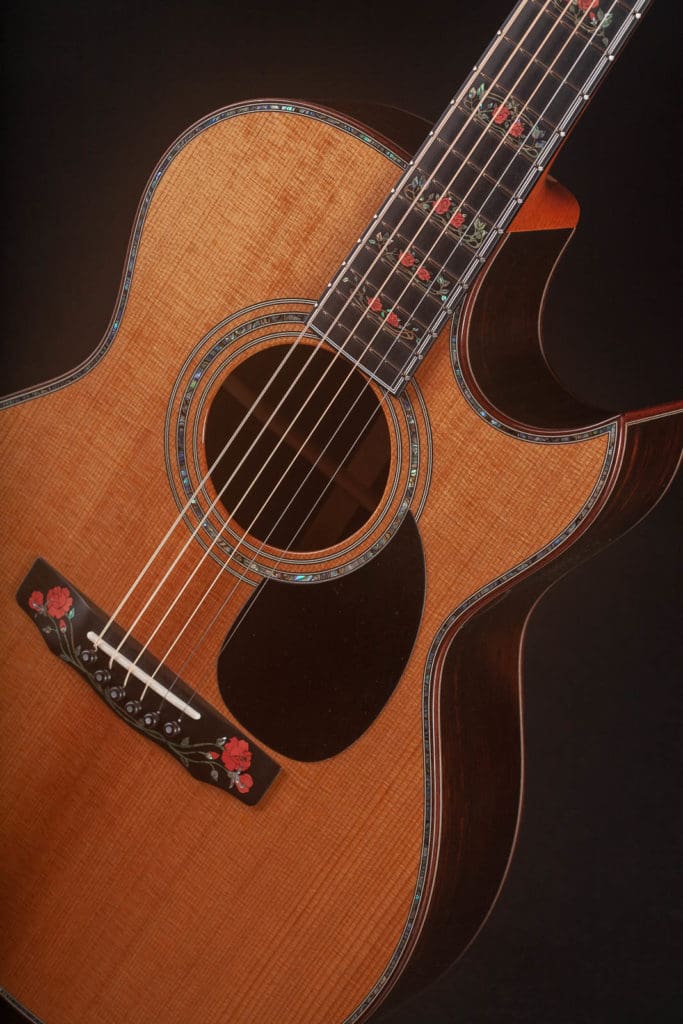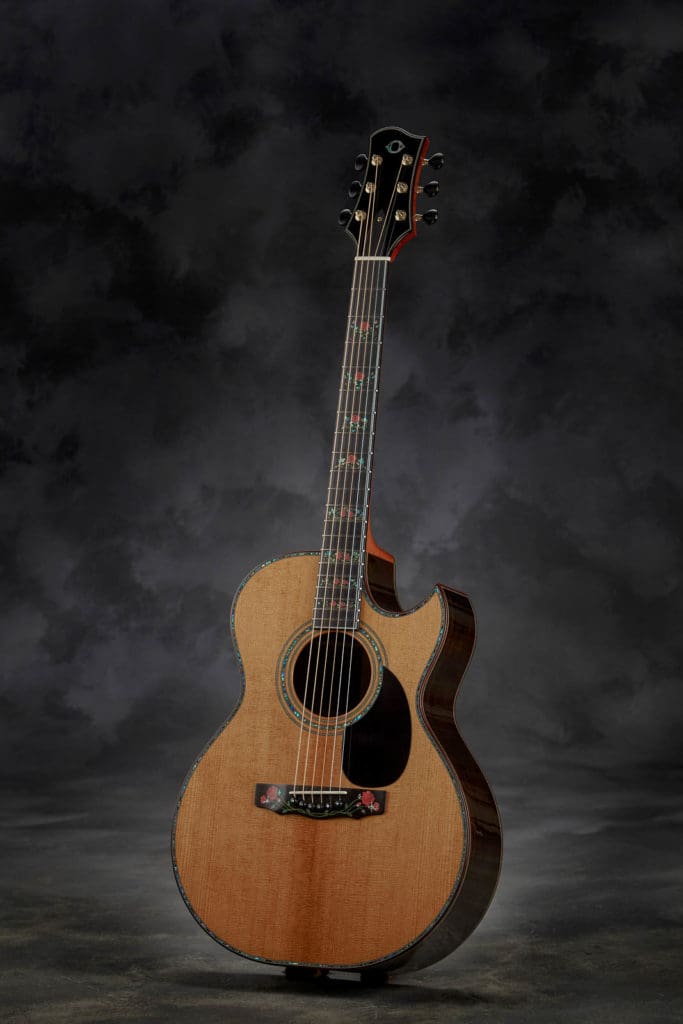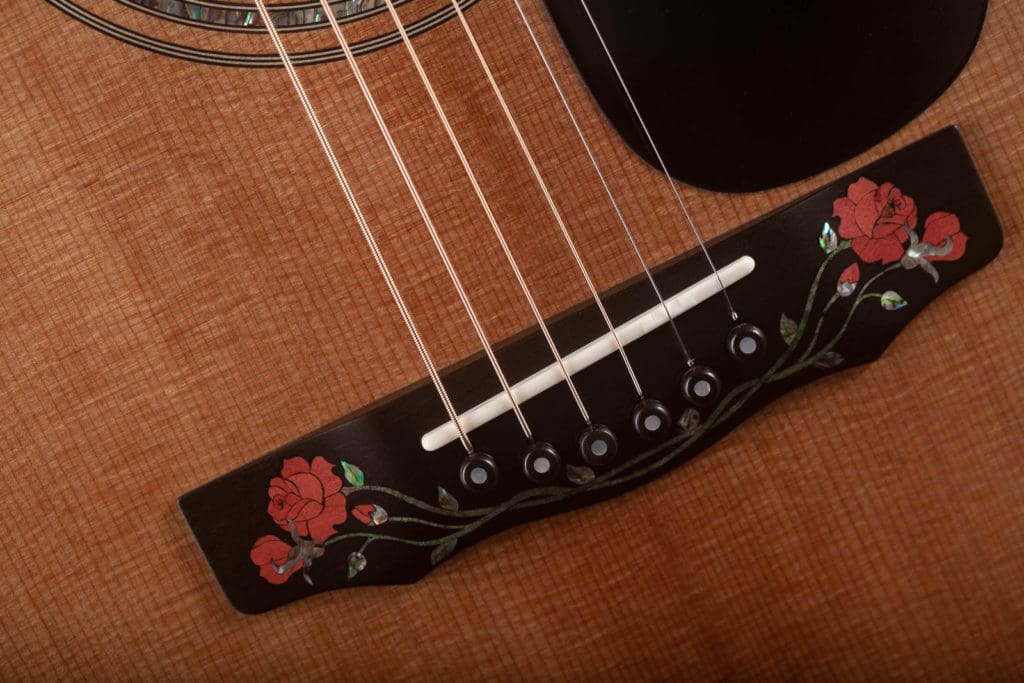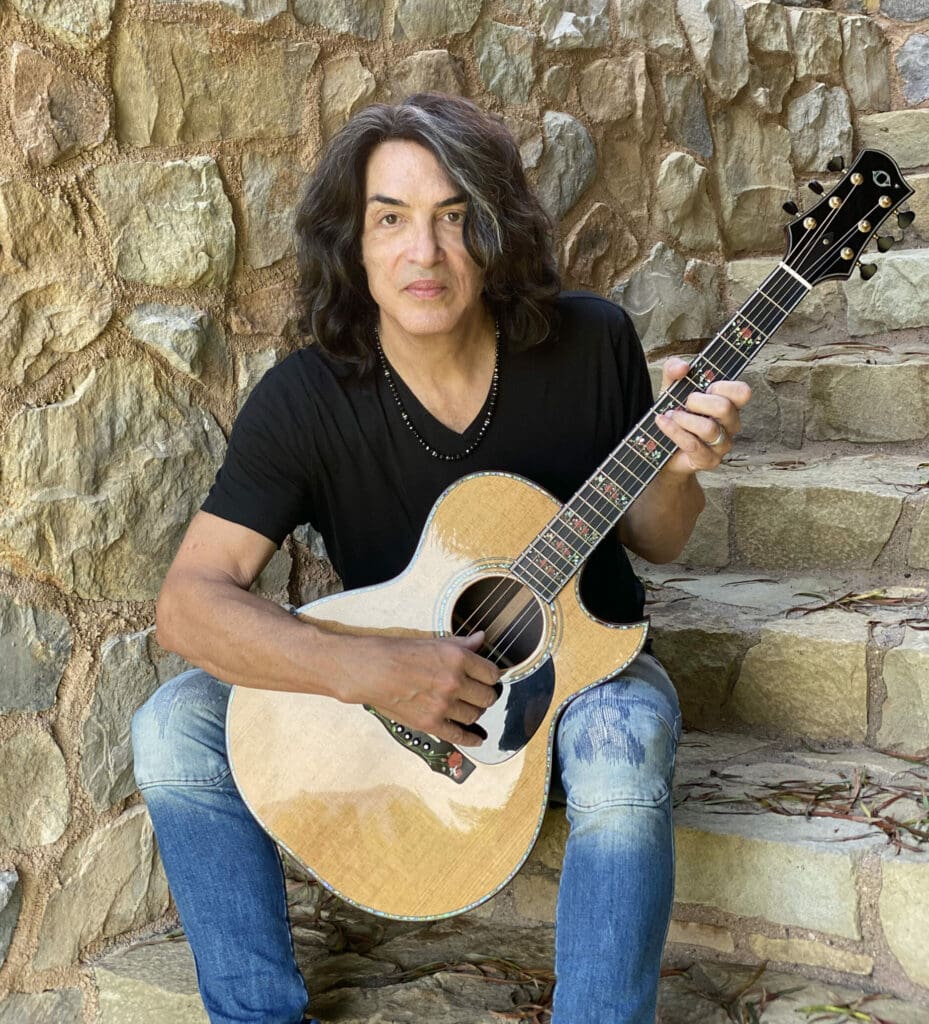It goes without saying that when you’re working on a story for the Fretboard Journal you’re going to cross paths with some incredible, even iconic instruments. I had the predictable expectations for the James Taylor feature in Issue 47 [you can read excerpts here], centered on the extraordinary instruments built for him by Jim Olson in his Circle Pines, Minnesota shop. The story brought me to guitars that defied expectation, that I’d never have dreamed of coming across in this context, incredible instruments that seemed to be related to Taylor only tangentially, at best, or really, not at all.
The roots of the story can be traced back several years, to the beginnings of the recordings that would become Taylor’s American Standard album, but the story didn’t really get started until the early days of 2020, leading up to the album’s release at the end of February. I found myself in New York City, where I got hit with a double-whammy of incredible guitars, out of the blue. I was tagging along with John Pizzarelli, who co-produced the album with Dave O’Donnell, on his way to a soundcheck for a promotional appearance with Taylor when we made a detour to TR Crandall, where John picked up a guitar Tom had been giving a little “refresh” — a 1936 D’Angelico tenor archtop that was converted to a 6-string, probably by D’Angelico himself, circa 1940 or soon thereafter. As if that were not enough to spin my head around, over on the shop bench I noticed Tom’s shop partner, Alex Whitman, was re-fretting a Telecaster… Julian Lage’s ’54 Telecaster. Two unbelievable but very different instruments, coincidentally in the same workshop at the same time, and yet neither the most surprising guitar this story had in store for me.

It wasn’t until a few months later that I was finally able to talk with James, and soon after I reached out to Jim Olson. Jim and I had a great chat — he’s one of the nicest guys in the business — that wandered well beyond the topic of James Taylor’s guitars and included a moment wherein Jim let it slip that he was building a guitar for Paul Stanley. Yeah, that Paul Stanley, of KISS, who you probably can’t picture playing anything but an Ibanez Iceman, even if “Hard Luck Woman” looms large in your personal history. Jim sent along a photo of the guitar on his bench, shortly before he finished the instrument, and it was absolutely fascinating, a mind-bending melding of Jim Olson and Paul Stanley, if you could possibly imagine it: an impeccable Brazilian rosewood SJ, simply decorated with inlaid roses as position markers and adorning the bridge, courtesy of Larry Robinson.
How did this amazing thing come to pass? As a guy who might very well be beholden to Paul Stanley for sparking my interest in playing guitar in the first place — my best friend and I used to play air guitar along to Alive II, from start to finish, as 11-year olds — I had to know, and Jim was happy to make the connection.
Fretboard Journal: How did you find Jim?
Paul Stanley: Well, I guess it was meant to be, but, I’m a huge James Taylor fan — he’s consummate, in every respect, from his singing to his writing to his playing — and I was curious about his guitar. Of course, if you could buy that guitar and play like him I would have bought one long ago.
I went to Jim’s website and it just resonated with me. I think the idea of having one person build a guitar, singularly, to conceptualize something, to collaborate, is almost spiritual; it’s a very deep and intimate kind of process and relationship, and I’d never done it. I really felt like I owed it to myself. My roots are in acoustic guitars and I thought, regardless of — let’s not kid ourselves, Jim’s guitars are not inexpensive, but they are really top of the line as far as I’m concerned. If you look at the websites of some other guitar builders they either thank him or cite him, and it’s because of his nature. Here’s a guy who’s nurtured and helped other luthiers and, as I got to know him, he’s just a terrific, terrific guy. I think we had a great time. Once I committed to doing it and we got started it was very, very exciting and I have to say that the finished instrument — I’m smiling just thinking about it; it’s a creature with a soul, it’s not replicated in factories. It just has a resonance to it, even when you tap it, it’s just… it’s just… it’s a being, as opposed to an instrument. It’s unique…
I’m fairly articulate and I have a hard time putting it into words. It has a soul to it, and there’s such integrity and commitment by Jim that it’s in its DNA. It’s a work of art but also a work of love.

FJ: Can you tell me about the inlay?
PS: Other than artistically, I’m not really a fan of fretboards that are obliterated with inlay. I, for one, can’t figure out where I am on the fretboard most of the time. So I wanted to come up with something that would work as a “block” inlay, but I wanted something elegant and…Art Nouveau. So I went back to some of the works by [Émile] Gallé and [Louis] Majorelle — all these beautiful curves — and roses have been connected to me through the band, so I wanted to incorporate roses, and it worked! Then it was just a matter of… Jim has worked with Larry Robinson before, and I have to say that in researching all the inlay artists that are most prominent, although their work is beautiful and intricate, it lacks the delicacy and subtlety of Larry’s work, so Larry was a natural. He made it happen, and it’s elegant without being garish. I’m just not a fan of those fingerboards with skyscrapers and city scenes or flying saucers. And then I wanted to pull the design down into the bridge, so I designed that inlay for the bridge and it just pulls everything together, but it’s only ornamentation on an amazing guitar.
FJ: And the guitar itself…
PS: I love the torrefied top because it’s such a rich, rich color, other than this interesting concept of speeding up the aging process of wood through pressure and low heat, so it’s much more than a cosmetic toasting of the wood; it’s actually what’s going on in it. I think Jim had done one other guitar [with a torrefied top] and I was interested in using that process. We both wanted Braziian rosewood. I did some looking around, but the great thing is that Jim has a great stockpile of woods that he’s kept and that he has seasoned and controlled, so I grabbed two of his pieces of the Brazilian for the back.
In a way I almost justified the project, it’s kind of a culmination of this side of my musical journey. Kind of like giving myself, not that I’m retiring, but giving myself the gold watch, you know? At some point I will record with it. I have to believe it would just be a stunning guitar to record. I just pick it up and smile. It’s totally mine. When I look at it I go, “Yes! That’s the guitar that I envisioned.” It’s like a great pair of custom-made boots, or your favorite jeans.
I got a Calton case, which, from what I understand, you could drop it from two stories — which I have no desire to find out! If there could be a visual: every time you open the case light would come out. It’s the magic guitar. AND everybody who’s seen it, even the photos, it’s gorgeous without being garish.
FJ: Did you get to visit the shop?
PS: No. We were in constant contact. There’s a certain amount of trust that has to go into it, too. It was a great process — we were on the phone all the time. The more we got to know each other, the more of a commitment there was, certainly by Jim, to make the guitar special.
I sent him, while he was making it, a framed giclée, a high-res print on canvas, of one of my pieces of Robert Johnson, that I painted on additionally to make it another original. I think that bonding, again, gets transferred into the work process. Last week Jim sent me a photo of his mom playing my guitar. We hit it off really nicely and I do think that there’s no substitute for that kind of connection. I’ve always believed, just in terms of work-related relationships, I try to tell people that you get much more from the people you work with when they like you than when they fear you. But in this case, this wasn’t a “working” relationship. This was more a collaboration, where a friendship grew.
FJ: When did you reach out to Jim?
PS: I don’t know if it was more than six months ago. We talked, and the more we talked, I think the more he became immersed in it, and he just kept working at it. I think it became a passion project.
I kept saying to him — he wanted so much for it to be great — and I said, “It is and it will be, because you’re putting something intangible into it. Don’t worry about it! It is that great.” And that’s before I ever picked it up. There’s something unique that comes from an emotional connection to your work.
FJ: What’s the first thing you played on it?
PS: “In My Life,” by The Beatles. Judy Collins did a beautiful version of that, and I kind of tapped into that a little bit more. That was the first thing that I played on it. It’s a lovely instrument. I know many of his players tend to be fingerpickers, and although I do a rudimentary, fake Travis pick, which I still have yet to learn, I use a flatpick, but the guitar is beautiful, you don’t want to beat it. It kind of reminds me, it’s funny, of a friend of mine, who’s a great pianist, who was saying, about getting what’s within a piano… it’s capabilities are dependent upon your ability. It’s a much too nice a guitar, I wouldn’t have the heart to strum with too much muscle, but it doesn’t need it, and I don’t think that it would get out of that guitar what’s in it. I think it needs a little love.

FJ: Every guitar you need to find its sweet spot, the way it wants to be played.
PS: Yeah.
FJ: Other than the inlay, did you have any other special requests? A particular neck carve?
PS: He has what is his standard and… I trusted him. I have large hands, it’s a very friendly and easy neck to play. It’s great.
FJ: Jim told me that you were once a guy with an acoustic guitar and a harmonica around your neck…
PS: A folkie. Yup. I was lucky because I grew up in a family where music was intrinsically a part of our lives. My mom was born in Germany and my dad was first generation from Poland. In Europe music is part of your diet, so I grew up with opera, classical music, Broadway, and rock & roll, and then that also lead me to what was being called “folk music,” the offspring of Woody Guthrie. You had Dylan and Eric Anderson and Phil Ochs and Buffy Saint-Marie, Tim Hardin… the list goes on and on. So, yeah, at one point I had a harmonica brace around my neck and an acoustic guitar. It’s a part of my DNA.
FJ: What sorts of acoustics did you have before this one?
PS: I have two Guild F-50s. I have a 12-string from the mid-‘70s, which is really, just a terrific guitar. I just love that guitar. And then I’ve got a blonde, maple one from the ‘80s, a 6-string, which is just the coolest-looking guitar. I’ve got a D-41, purple myrtle Martin that I got from them just this year, which is a gorgeous instrument, it plays beautifully… I have a ’54 00-18. I have a ’54 Gibson J-200… I’ll tell ya, the interesting thing about J-200s, and I’ve loved the aesthetic since I was a kid, I love the mustache bridge, but I don’t find them to sound the way I expect them to. I find that my F-50 sounds more like what I want it to sound like. I had a ’39 rosewood J-200 and ’55 blonde J-200 and I was always surprised that they all lacked what I was really looking for. Aesthetically I love ‘em. I just find, everyone I pick up, “Oh, that sounds like the other one!”
I like Jumbos. I’m trying to push it out of my mind, but I find myself thinking, “Maybe I’ll ask Jim to make me a Jumbo.” Or make me a dreadnought. But the SJ is terrific. It’s not too small by any means. It’s an elegant guitar, it plays beautifully, it’s just a jewel. I’m not averse to doing either a Jumbo or a single-cut dreadnought, but that’s not to say that this guitar is not the ultimate — it might need a brother or a sister, but it’s very, very special.

FJ: That’s the trouble with working with a builder and developing a rapport, isn’t it? It’s hard to avoid the temptation to get another guitar to keep the relationship going.
PS: Well, you know, telephone calls are much cheaper… but the collaborative effort and the excitement of “What can we do?” or “Can we do this?” That’s a very unique experience. The collaborative process, whether it’s songwriting or building something, it’s very unique, to find somebody that you enjoy communicating with and also is as talented as that makes you want to continue.

In addition to working with Jim Olson on this beautiful guitar, Paul Stanley has been working on another labor of love, a Motown/Philly soul project, Paul Stanley’s Soul Station, and a new album, Now and Then, out March 19th.
“I only sing,” Paul tells me. “We do all the great classics. We do them with reverence and respect. I’m much more interested in recreating the recorded version than the Las Vegas version. [The record has] five new tracks on it. Unfortunately, now [during the pandemic], we’re not in a position to go play live.”
Talking to him, it’s clear that he’s very into the roots of soul and r&b music.
“I was lucky,” he admits, reverently. “I saw Otis Redding live. I saw Solomon Burke, the Temps…so Motown/Philly soul, Stax/Volt, Muscle Shoals, it’s in there! I think what makes a person’s music have depth, or be unique somewhat, is what’s in there that’s unexpected. If all you’d listen to is music that sounds like your music, it’s pretty shallow. Do I think Puccini would roll over in his grave to know that he influenced me? Maybe! But I say thanks! Motown/Philly soul…there are certain songs that KISS has done that basically are just those kinds of songs done differently. The lead vocal call and response in ‘Shout It Out Loud’ is The Four Tops!
“For me, I don’t want to say it was a vanity project: It was a passion project! To hear the Delfonics or the Stylistics, live, with me! It was pretty thrilling.”
Editor’s Note: This story originally appeared in the Fretboard Journal #47.
Guitar photos by Jim Olson. Paul Stanley photo uncredited.


